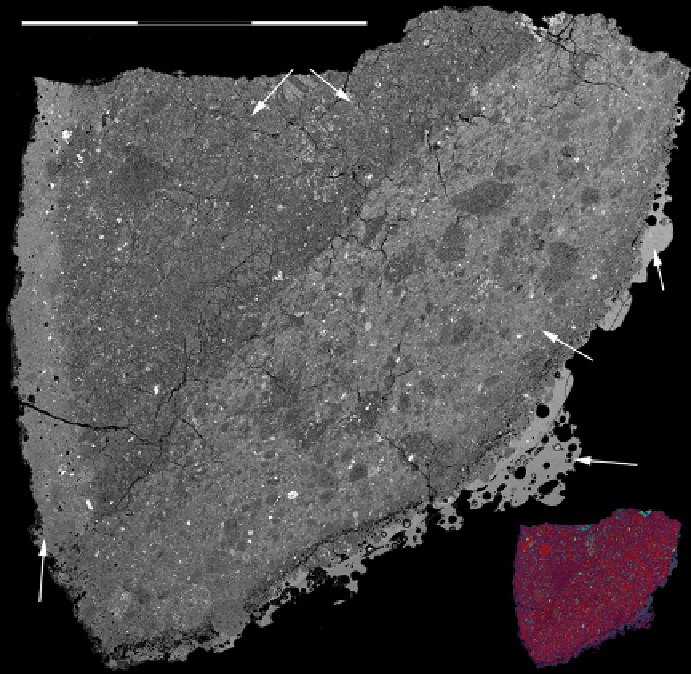Geology Reference
In-Depth Information
entire range of olivine compositions (Fo
7-93
); most clasts
are at the Mg-rich end of the range, however. Most pyroxene
mineral clasts are exsolved, with augite and orthopyroxene
lamellae ranging from submicron all the way up to nearly
100 µm thickness. A single large (200 × 150 µm) basaltic
spherule is present. It is partially devitrified with magne-
sian olivine (Fo
78
) quenching out of the glass. It has a bulk
composition very similar to
Apollo
15 yellow pyroclastic
glass [
Shearer and Papike
, 1993].
Our bulk sample is only 57 mg in mass, from which
we made two INAA subsamples, both of which we subse-
quently analyzed for major elements. Despite being a
regolith breccia, GRA 06157 has low concentrations of
siderophile elements compared to most regolith breccias
[
Korotev et al
., 2009a] (Figure 6.9). GRA 06157 is one of
the most feldspathic meteorites studied here (29 wt.%
Al
2
O
3
). Our sample is distinct in being more magnesian
(
Mg' =
77 ± 4) than both any other lunar meteorite from
Antarctica (Table 6.1) and any lunar meteorite composed
of feldspathic regolith breccia of which we are aware
(Figure 6.7). The magnesian nature is likely caused by the
presence of the highly magnesian olivine present in the
troctolitic granulite clasts and olivine mineral clasts.
6.5.11. Larkman Nunatak 06638
LAR 06638 is another small (5.3 g) meteorite. The rock
is a dark-matrix regolith breccia with millimeter-size
light-colored clasts and one large (~1 cm), light-colored
breccia clast that represents a significant proportion of
the total mass of the meteorite [
Satterwhite and Righter
,
2007]. The large white clast is a fragmental breccia (there
is no glassy matrix). The thin section in this study (LAR
06638,13) has both prominent lithologies present: 60%
dark-matrix material and 40% light-colored clast material
(Figure 6.16) [
Zeigler and Korotev
, 2013]. The dark-
matrix area consists of granulite, impact-melt breccia,
mineral, and glass clasts set in a glassy matrix, whereas
the light-colored clast area consists of granulite and min-
eral clasts set in a fragmental matrix. The lithic clast
population of the dark-matrix area is dominated by feld-
spathic granulite clasts, with a few feldspathic impact-
melt breccia clasts also present. Both the granulite and
impact-melt clasts are dominated by calcic plagioclase
(An
95-99
; almost always >90% by mode). The granulite
clasts contain minor amounts of pyroxene and olivine
that range widely in size (1-50 µm; typically <10 µm).
3 mm
BSE image
White-clast area
Glass
coating
Dark-matrix
area
Fusion
crust
R = Al
G = Mg
B = Fe
Partially
melted
glassy area
RGB
X-ray Map
LAR 06638,13
Figure 6.16.
Back-scattered electron image (Figure 6.6) and an RGB (red, green, blue) elemental x-ray map of a thin section of
lunar meteorite LAR 06638. The scale bar applies only to the BSE image.

